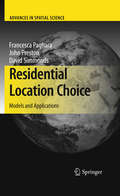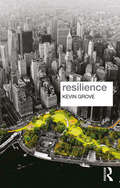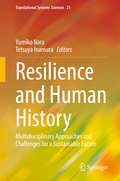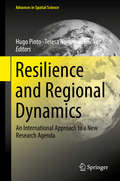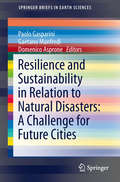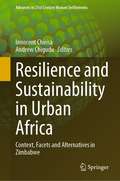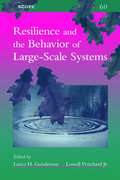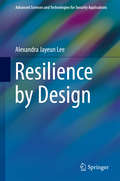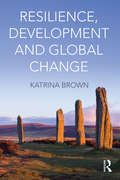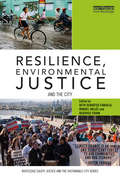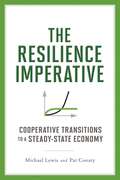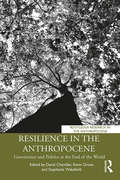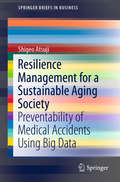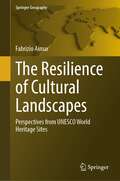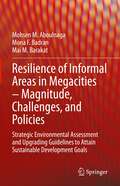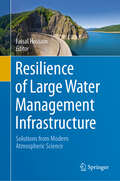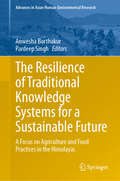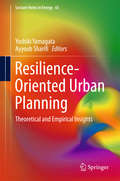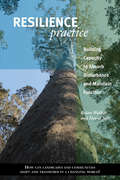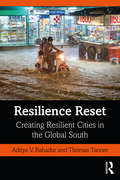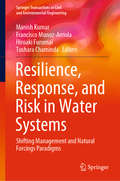- Table View
- List View
Residential Location Choice: Models and Applications
by David Simmonds John Preston Francesca PagliaraThe effective planning of residential location choices is one of the great challenges of contemporary societies and requires forecasting capabilities and the consideration of complex interdependencies which can only be handled by complex computer models. This book presents a range of approaches used to model residential locations within the context of developing land-use and transport models. These approaches illustrate the range of choices that modellers have to make in order to represent residential choice behaviour. The models presented in this book represent the state-of-the-art and are valuable both as key building blocks for general urban models, and as representative examples of complexity science.
Residential Water Demand: Alternative Choices for Management
by Angelo P. GrimaThis detailed study of the use of water at different price levels by residential consumers in the Toronto-centred region from Hamilton to Oshawa challenges the basis of our present urban water supply policy. Adoption of the recommendations presented would mean higher prices to householders, but a considerable saving of hundreds of millions of tax dollars over the next three decades. The present policy uses a 'requirement approach' in which future water needs are calculated by extrapolation of past trends and an assumption that demand is inelastic. This leads to excessive levels of water use and over-investment in water supply, sewage collection, and treatment systems. The resultant misallocation of resources can be corrected by adoption of a demand/management approach in which investment policy is guided by consumer demand and alternative pricing arrangements are used as a management tool. Dr. Grima examines several alternative choices for management, such as metering, increasing marginal prices, sewerage charges, seasonal charges, and an increasing price block schedule, and describes the results of each. Water managers in Canada are strongly challenged to begin a fundamental rethinking of their basic policies. (Department of Geography Research Publication 7)
Resilience (Key Ideas In Geography Ser.)
by Kevin GroveIs resilience simply a fad, or is it a new way of thinking about human–environment relations, and the governance of these relations, that has real staying power? Is resilience a dangerous, depoliticizing concept that neuters incipient political activity, or the key to more empowering, emancipatory, and participatory forms of environmental management? Resilience offers an advanced introduction to these debates. It provides students with a detailed review of how the concept emerged from a small corner of ecology to critically challenge conventional environmental management practices, and radicalize how we can think about and manage social and ecological change. But Resilience also situates this new style of thought and management within a particular historical and geographical context. It traces the roots of resilience to the cybernetically-influenced behavioral science of Herbert Simon, the neoliberal political economic theory of new institutional economics, the pragmatist philosophy of John Dewey, and the modernist design aesthetic of the Bauhaus school. These diverse roots are what distinguish resilience approaches from other ways of studying human-environment relations. Resilience thinking recalibrates the study of social and environmental change around a will to design, a drive or desire to synthesize diverse forms of knowledge and develop collaborative, cross-boundary solutions to complex problems. In contrast to the modes of analysis and critique found in geography and cognate disciplines, resilience approaches strive to pragmatically transform human–environment relations in ways that will produce more sustainable futures for complex social and ecological systems. In providing a road map to debates over resilience that brings together research from geography, anthropology, sociology, international relations, and philosophy, this book gives readers the conceptual and theoretical tools necessary to engage with political and ethical questions about how we can and should live together in an increasingly interconnected and unpredictable world.
Resilience and Human History: Multidisciplinary Approaches and Challenges for a Sustainable Future (Translational Systems Sciences #23)
by Yumiko Nara Tetsuya InamuraThis unique book provides a platform for resilience research, combining knowledge from various domains, such as genetics, primatology, archeology, geography, physical anthropology, cultural anthropology, medicine, ecology, psychology, risk management and systems science, in order to examine specific concepts. The term "resilience" was originally used in psychology, but in current-day usage, it mainly refers to the "ability to recover from disaster"; however, the concept of resilience is still ambiguous. This book challenges readers to reconsider the concept of resilience comprehensively from diverse perspectives and to re-conceptualize it as an important framework applicable in various research fields. The book explores resilience by expanding the time and space scales to the maximum. On the time axis, it traces back to our human ancestors (and even to anthropoid apes) and follows the evolution of humans, the origin of agriculture, the rise and fall of ancient civilizations, and the present day. On the space axis, it discusses levels ranging from genetic; bacterial flora; individual, indigenous communities; and modern societies; to the global level. As such it expands the base for considering the problems facing modern society and selecting a future direction. In the long history of evolution, we Homo sapiens have faced, and overcome, various kinds of risks. By acquiring resilience, we have surpassed other animals and become apparent rulers of the earth; but, at the same time, we are also facing more serious risks than ever before. This book provides insights into addressing the challenges of a sustainable future.
Resilience and Regional Dynamics: An International Approach to a New Research Agenda (Advances in Spatial Science)
by Eric Vaz Teresa Noronha Hugo PintoEconomic and financial crises have brought the rise of unemployment, reduction of economic growth and emergence of global imbalances and tensions as countries and regions have suffered the effects of a variety of internal and external shocks. In this context of constant disruption, the scientific community has struggled to provide satisfactory answers to current economic challenges within standard frameworks. Focusing on the interconnections between innovation and resilience, this edited book contributes to a better understanding of how the crisis affects innovation and the capacity of territories to adapt and evolve. It offers both theoretical and empirical contributions that debate the notions of resilience in regional and urban contexts and serve as case studies related to innovation strategies and territorial clusters.
Resilience and Sustainability in Relation to Natural Disasters: A Challenge for Future Cities
by Paolo Gasparini Gaetano Manfredi Domenico AsproneThe number of megacities worldwide is rapidly increasing and contemporary cities are also expanding fast. As a result, cities and their inhabitants are becoming increasingly vulnerable to the effects of catastrophic natural events such as extreme weather events (recently more frequent and intense as a result of the ongoing climate changes), earthquakes, tsunamis or man-induced events such as terrorist attacks or accidents. Furthermore, due to increasing technological complexity of urban areas, along with increasing population density, cities are becoming more and more risk attractors. The resilience of cities against catastrophic events is a major challenge of today. It requires city transformation processes to be rethought, to mitigate the effects of extreme events on the vital functions of cities and communities. Redundancy and robustness of the components of the urban fabric are essential to restore the full efficiency of the city's vital functions after an extreme event has taken place. These items were addressed by an interdisciplinary and international selection of scientists during the 6th UN-World Urban Forum that was held in Naples, Italy in September 2012. This volume represents in six chapters the views from sociologists, economists and scientists working on natural risk and physical vulnerability on resilience and sustainability for future cities in relation to natural disasters.
Resilience and Sustainability in Urban Africa: Context, Facets and Alternatives in Zimbabwe (Advances in 21st Century Human Settlements)
by Innocent Chirisa Andrew ChiguduResilience has become a very topical issue transcending many spheres and sectors of sustainable urban development. This book presents a resilience framework for sustainable cities and towns in Africa. The rise in informal settlements is due to the urban planning practices in most African cities that rarely reflect the realities of urban life and environment for urban development. Aspects of places, people and process are central to the concept of urban resilience and sustainable urban growth. It stems from the observation that urban vulnerability is on the increase in Zimbabwe and beyond. In history, disasters have adversely affected nations across the world, inflicting wide ranging losses on one hand while on the other hand creating development opportunities for urban communities. Cooperation in disaster management is a strategy for minimising losses and uplifting the affected urban settlements. The significance of urban planning and design in the growth and development of sustainable urban centres is well documented. Urbanisation has brought with it challenges that most developing countries such as Zimbabwe are not equipped to handle. This has been accompanied by problems such as overpopulation, overcrowding, shortages of resources and the growth of slum settlements. There need is to seriously consider urban planning and design in order to come up with contemporary designs that are resilient to current urban challenges. There are major gaps in urban resilience building for instance in Harare and the local authority needs to prioritise investment in resilient urban infrastructure.
Resilience and the Behavior of Large-Scale Systems (SCOPE Series #60)
by Lance H. Gunderson Lowell PritchardScientists and researchers concerned with the behavior of large ecosystems have focused in recent years on the concept of "resilience." Traditional perspectives held that ecological systems exist close to a steady state and resilience is the ability of the system to return rapidly to that state following perturbation. However, beginning with the work of C. S. Holling in the early 1970s, researchers began looking at conditions far from the steady state, where resilience is measured by the magnitude of disturbance that can be absorbed before the system is restructured.Resilience and the Behavior of Large-Scale Systems examines theories of resilience and change, offering readers a thorough understanding of how the properties of ecological resilience and human adaptability interact in complex, regional-scale systems. The book addresses theoretical concepts of resilience and stability in large-scale ecosystems and the empirical application of those concepts in a diverse set of cases. In addition, it discusses the practical implications of new theoretical approaches and their role in the sustainability of human-modified ecosystems.The book begins with a review of key properties of complex adaptive systems that contribute to overall resilience, including multiple equlibria, complexity, self-organization at multiple scales, and order. Following the introduction are case studies that explore the biophysical dimensions of resilience in terrestrial and aquatic systems, and evaluate the propositions presented. The book concludes with a synthesis section that revisits propositions in light of the case studies, while an appendix presents a detailed account of the relationship between return times for a disturbed system and its resilience.In addition to the editors, contributors include Stephen R. Carpenter, Carl Folke, C. S. Holling, Bengt-Owe Jansson, Donald Ludwig, Ariel Lugo, Tim R. McClanahan, Garry D. Peterson, and Brian H. Walker.
Resilience and the Cultural Landscape
by Tobias Plieninger Claudia BielingAll over the world, efforts are being made to preserve landscapes facing fundamental change as a consequence of widespread agricultural intensification, land abandonment and urbanisation. The 'cultural landscape' and 'resilience' approaches have, until now, largely been viewed as distinct methods for understanding the effects of these dynamics and the ways in which they might be adapted or managed. This book brings together these two perspectives, providing new insights into the social-ecological resilience of cultural landscapes by coming to terms with, and challenging, the concepts of 'driving forces', 'thresholds', 'adaptive cycles' and 'adaptive management'. By linking these research communities, this book develops a new perspective on landscape changes. Based on firm conceptual contributions and rich case studies from Europe, the Americas and Australia, it will appeal to anyone interested in analysing and managing change in human-shaped environments in the context of sustainability.
Resilience by Design
by Alexandra Jayeun LeeThis book discusses that disasters, whether natural or man-made, are essentially a human phenomenon. When a city becomes gridlocked and its resources depleted, the collective resilience of those who remain on the ground becomes critical to its immediate survival and recovery. The author argues that in order to build resilient futures for our urban environment, we need more than the skills of architects, engineers, and planners. Support of local communities and policymakers is also needed. The book revisits the recent catastrophic events: the earthquakes in Port-au-Prince and Christchurch, and the hurricane in New Orleans, and places emphasis on the social, cultural, and political processes of rebuilding houses, facilities, and infrastructure that often go unnoticed. Understanding the wider context for how a built project comes to be, the author argues, is a solid indicator of its longevity than by the measure of its material characteristics alone, and gives us reasons to question the validity of our intentions as designers of the future. This book provides strategies for thinking about, assessing, and developing ways for place-makers from all disciplines to become responsible citizen designers of our cities.
Resilience, Development and Global Change
by Katrina BrownResilience is currently infusing policy debates and public discourses, widely promoted as a normative goal in fields as diverse as the economy, national security, personal development and well-being. Resilience thinking provides a framework for understanding dynamics of complex, inter-connected social, ecological and economic systems. The book critically analyzes the multiple meanings and applications of resilience ideas in contemporary society and to suggests where, how and why resilience might cause us to re-think global change and development, and how this new approach might be operationalized. The book shows how current policy discourses on resilience promote business-as-usual rather than radical responses to change. But it argues that resilience can help understand and respond to the challenges of the contemporary age. These challenges are characterized by high uncertainty; globalized and interconnected systems; increasing disparities and limited choices. Resilience thinking can overturn orthodox approaches to international development dominated by modernization, aid dependency and a focus on economic growth and to global environmental change – characterized by technocratic approaches, market environmentalism and commoditization of ecosystem services. Resilience, Development and Global Change presents a sophisticated, theoretically informed synthesis of resilience thinking across disciplines. It applies resilience ideas specifically to international development and relates resilience to core theories in development and shows how a radical, resilience-based approach to development might transform responses to climate change, to the dilemmas of managing forests and ecosystems, and to rural and urban poverty in the developing world. The book provides fresh perspectives for scholars of international development, environmental studies and geography and add new dimensions for those studying broader fields of ecology and society.
Resilience, Environmental Justice and the City (Routledge Equity, Justice and the Sustainable City series)
by Beth Schaefer Caniglia Manuel Vallee Beatrice FrankUrban centres are bastions of inequalities, where poverty, marginalization, segregation and health insecurity are magnified. Minorities and the poor – often residing in neighbourhoods characterized by degraded infrastructures, food and job insecurity, limited access to transport and health care, and other inadequate public services – are inherently vulnerable, especially at risk in times of shock or change as they lack the option to avoid, mitigate and adapt to threats. Offering both theoretical and practical approaches, this book proposes critical perspectives and an interdisciplinary lens on urban inequalities in light of individual, group, community and system vulnerabilities and resilience. Touching upon current research trends in food justice, environmental injustice through socio-spatial tactics and solution-based approaches towards urban community resilience, Resilience, Environmental Justice and the City promotes perspectives which transition away from the traditional discussions surrounding environmental justice and pinpoints the need to address urban social inequalities beyond the build environment, championing approaches that help embed social vulnerabilities and resilience in urban planning. With its methodological and dynamic approach to the intertwined nature of resilience and environmental justice in urban cities, this book will be of great interest to students, scholars and practitioners within urban studies, environmental management, environmental sociology and public administration.
The Resilience Factor: A Step-by-Step Guide to Catalyze an Unbreakable Team
by Ryan T. Hartwig Léonce B. Crump Jr. Warren BirdWant to unleash the "remarkable" in your team? The potential of a team of God-inspired, talented, committed people is boundless. But without resilience—including the savvy and skill to get up again (and again) when the going gets tough—teams simply cannot thrive or lead well. Resilience is what sets great leaders and teams apart from those that literally fall apart. It's what's missing when great organizations lose steam. Ryan T. Hartwig, Léonce B. Crump Jr., and Warren Bird have worked with team members in many kinds of churches and Christian organizations, served on numerous teams, and surfaced the best research on teams. In The Resilience Factor, they distill this wisdom into a series of practical steps that promise to both inspire and equip teams to move from floundering to flourishing. Filled with examples of top-performing teams, individual and group reflection questions, diagnostic tools, and team activities, The Resilience Factor promises to become the go-to resource for leaders who want to release remarkable resilience in their teams.
The Resilience Imperative: Cooperative Transitions to a Steady-State Economy
by Michael Lewis Pat Conaty“[The authors] argue that with more integration and cooperation between businesses, governments and communities, a more sustainable economy is possible.” —The Environmental MagazineWe find ourselves between a rock and a hot place—compelled by the intertwined forces of peak oil and climate change to reinvent our economic life at a much more local and regional scale. The Resilience Imperative argues for a major SEE (social, ecological, economic) change as a prerequisite for replacing the paradigm of limitless economic growth with a more decentralized, cooperative, steady-state economy.The authors present a comprehensive series of strategic questions within the broad areas of:Energy sufficiencyLocal food systemsInterest-free financingAffordable housing and land reformSustainable community developmentEach section is complemented by case studies of pioneering community initiatives rounded out by a discussion of transition factors and resilience reflections.With a focus on securing and sustaining change, this provocative book challenges deeply embedded cultural assumptions. Profoundly hopeful and inspiring, The Resilience Imperative affirms the possibilities of positive change as it is shaped by individuals, communities, and institutions learning to live within our ecological limits.“Resilience is the watchword for our dawning era of economic and environmental instability . . . The Resilience Imperative is exactly what’s needed to get us moving in the right direction.” —Richard Heinberg, author of Power: Limits and Prospects for Human Survival“Exceptionally valuable—in vision, in strategic understanding, in concrete ways to build forward. A handbook for a morally meaningful and sustainable future!” —Gar Alperovitz, author of America Beyond Capitalism
Resilience in the Anthropocene: Governance and Politics at the End of the World (Routledge Research in the Anthropocene)
by David ChandlerThis book offers the first critical, multi-disciplinary study of how the concepts of resilience and the Anthropocene have combined to shape contemporary thought and governmental practice. Faced with the climate catastrophe of the Anthropocene, theorists and policymakers are increasingly turning to ‘sustainable’, ‘creative’ and ‘bottom-up’ imaginaries of governance. The book brings together cutting-edge insights from leading geographers, international relations scholars and philosophers to explore how the concepts of resilience and the Anthropocene challenge and transform prevailing understandings of Earth, space, time and knowledge, and how these transformations reshape governance, ethics and critique today. This book examines how the Anthropocene calls into question established categories through which modern societies have tended to make sense of the world and engage in critical reflection and analysis. It also considers how resilience approaches attempt to re-stabilize these categories – and the ethical and political effects that result from these resilience-based efforts. Offering innovative insights into the problem of how environmental change is known and governed in the Anthropocene, this book will be of interest to students in fields such as geography, international relations, anthropology, science and technology studies, sociology, and the environmental humanities.
Resilience Management for a Sustainable Aging Society: Preventability of Medical Accidents Using Big Data (SpringerBriefs in Business)
by Shigeo AtsujiThis book utilizes big data to undertake a cluster analysis of medical accidents. Highlighting shared worldwide accident patterns, it represents a first step toward reducing the incidence of accidents through kaizen innovation driven by information and communications technology. This initiative comes against a background where medical accidents are currently the third largest cause of death after heart attack and cancer, making accident prevention an urgent concern. With the objective of preventing these accidents, which negatively impact numerous different stakeholders, and based on interdisciplinary research, the book examines (1) the application of data mining to identify shared accident patterns; (2) proposals for system improvement and organizational innovation aimed at risk and resilience in crisis management; and (3) the use of a global platform to achieve sustainability in the Internet of Medicine (IoM).
The Resilience of Cultural Landscapes: Perspectives from UNESCO World Heritage Sites (Springer Geography)
by Fabrizio AimarThis book explores the possibility of building the resilience of the UNESCO cultural landscapes, both using theoretical conceptions and practical strategies and actions. Two case studies have been selected, one in Italy and one in China, which have then been explored for the first time in such a comparative way. Different notions of landscape, as well as the driving force of changes affecting these landscapes, are examined and compared. Moreover, the perceptions of the local communities regarding these landscapes are examined, using online questionnaires with over 400 participants. This research highlights the need for an integrated management system, building stronger rural communities able to manage change and continuity. Five pillars to build the resilience of these landscapes have been provided, with schemes and figures, requiring a people-centered approach in their management. This book demonstrates strong connections between identity and landscape resilience, especially in inlandareas where the sense of identity is most prominent. Furthermore, it is structured to make it possible to replicate this investigation in ordinary case studies, i.e. ordinary landscapes. Scholars and professionals interested in cultural landscapes and heritage conservation are target of this book, as well as site managers.
Resilience of Informal Areas in Megacities – Magnitude, Challenges, and Policies: Strategic Environmental Assessment and Upgrading Guidelines to Attain Sustainable Development Goals
by Mohsen M. Aboulnaga Mona F. Badran Mai M. BarakatThis book focuses on the socio-economic and sustainability challenges facing megacities in dealing with the dramatic population increases of informal areas and settlements (or slums), especially when coupled with the impacts and risks of climate change. The authors examine informal urban areas globally and in developing countries utilizing strategic environmental assessment (SEA) as a tool to solve the sequence of upgrading steps concerning slums and shanty towns, and also establish essential guidelines for local governments and stakeholders to create a balance and quality of life for slums dwellers, particularly in the age of the COVID-19 pandemic, through applying sustainability indicators that enhance the upgrading process. Coverage includes recent statistics and mapping of informal areas worldwide and assessment of the GIZ and Sir Norman Foster models in terms of energy demands and consequential emission of CO2 and air pollution from slums. Three models of Maspero’s Triangle are also studied and assessed. The book is essential reading for a wide range of researchers, students, policymakers, governments, and professionals as well as a good source for research centers and academicians working in energy, climate change, urban environments, and sustainable urban development.
Resilience of Large Water Management Infrastructure: Solutions from Modern Atmospheric Science
by Faisal HossainInfrastructure that manages our water resources (such as, dams and reservoirs, irrigation systems, channels, navigation waterways, water and wastewater treatment facilities, storm drainage systems, urban water distribution and sanitation systems), are critical to all sectors of an economy. Realizing the importance of water infrastructures, efforts have already begun on understanding the sustainability and resilience of such systems under changing conditions expected in the future. The goal of this collected work is to raise awareness among civil engineers of the various implications of landscape change and non-climate drivers on the resilience of water management infrastructure. It identifies the knowledge gaps and then provides effective and complementary approaches to assimilate knowledge discovery on local (mesoscale)-to-regional landscape drivers to improve practices on design, operations and preservation of large water infrastructure systems.
The Resilience of Traditional Knowledge Systems for a Sustainable Future: A Focus on Agriculture and Food Practices in the Himalayas (Advances in Asian Human-Environmental Research)
by Anwesha Borthakur Pardeep SinghThis book is an effort to draw attention to the resilience of traditional knowledge systems for a sustainable future in the Himalayas with a particular focus on agriculture and food practices. Through examples from the region, it underscores the importance of these practices in navigating contemporary global environmental challenges. The Himalayan region, known for its socio-cultural diversity and unique agricultural ecology, emerges as a major hotspot of climate change. Therefore, acknowledging and recognizing the lived experiences of the locals along with their traditional knowledge associated with agriculture and food systems becomes imperative for devising adaptation and mitigation strategies amidst the unfolding environmental and climate crisis. Drawing upon insights from local communities and experts deeply rooted in the Himalayan context, this book not only documents traditional agricultural and food systems but also sheds light on the pressing anthropogenic challenges threatening their sustainability. We believe that research and documentation of traditional knowledge practices of the local and indigenous communities are essential for tackling the current and projected global environmental challenges.This book advocates for a holistic approach to addressing both current and future global environmental challenges. It serves as a timely call to action for researchers, policymakers, and practitioners alike.
Resilience-Oriented Urban Planning: Theoretical And Empirical Insights (Lecture Notes In Energy #65)
by Yoshiki Yamagata Ayyoob SharifiThis book explores key theoretical and empirical issues related to the development and implementation of planning strategies that can provide guidance on the transition to climate-compatible and low-carbon urban development. It especially focuses on integrating resilience thinking into the urban planning process, and explains how such an integration can contribute to reflecting the dynamic properties of cities and coping with the uncertainties inherent in future climate change projections.Some of the main questions addressed are: What are the innovative methods and processes needed to incorporate resilience thinking into urban planning? What are the characteristics of a resilient urban form and what are the challenges associated with integrating them into urban development? Also, how can the resilience of cities be measured and what are the main constituents of an urban resilience assessment framework? In addition to addressing these crucial questions, the book features several case studies from around the world, investigating methodologies, challenges, and opportunities for mainstreaming climate resilience in the theory and practice of urban planning. Featuring contributions by prominent researchers from around the world, the book offers a valuable resource for students, academics and practitioners alike.
Resilience Practice: Building Capacity To Absorb Disturbance And Maintain Function
by Brian Walker & David SaltIn 2006, Resilience Thinking addressed an essential question: As the natural systems that sustain us are subjected to shock after shock, how much can they take and still deliver the services we need from them? This idea caught the attention of both the scientific community and the general public. In Resilience Practice, authors Brian Walker and David Salt take the notion of resilience one step further, applying resilience thinking to real-world situations and exploring how systems can be managed to promote and sustain resilience. The book begins with an overview and introduction to resilience thinking and then takes the reader through the process of describing systems, assessing their resilience, and intervening as appropriate. Following each chapter is a case study of a different type of social-ecological system and how resilience makes a difference to that system in practice. The final chapters explore resilience in other arenas, including on a global scale. Resilience Practice will help people with an interest in the “coping capacity” of systems—from farms and catchments to regions and nations—to better understand how resilience thinking can be put into practice. It offers an easy-to-read but scientifically robust guide through the real-world application of the concept of resilience and is a must read for anyone concerned with the management of systems at any scale.
Resilience Practice: Building Capacity to Absorb Disturbance and Maintain Function
by Brian Walker David SaltIn 2006, Resilience Thinking addressed an essential question: As the natural systems that sustain us are subjected to shock after shock, how much can they take and still deliver the services we need from them? This idea caught the attention of both the scientific community and the general public. In Resilience Practice, authors Brian Walker and David Salt take the notion of resilience one step further, applying resilience thinking to real-world situations and exploring how systems can be managed to promote and sustain resilience. The book begins with an overview and introduction to resilience thinking and then takes the reader through the process of describing systems, assessing their resilience, and intervening as appropriate. Following each chapter is a case study of a different type of social-ecological system and how resilience makes a difference to that system in practice. The final chapters explore resilience in other arenas, including on a global scale. Resilience Practice will help people with an interest in the "coping capacity" of systems--from farms and catchments to regions and nations--to better understand how resilience thinking can be put into practice. It offers an easy-to-read but scientifically robust guide through the real-world application of the concept of resilience and is a must read for anyone concerned with the management of systems at any scale.
Resilience Reset: Creating Resilient Cities in the Global South
by Aditya V. Bahadur Thomas TannerDrawing on evidence from urban resilience initiatives around the globe, the authors make a compelling argument for a "resilience reset", a pause and stocktake that critically examines the concepts, practices and challenges of building resilience, particularly in cities of the Global South. In turn, the book calls for the world’s cities to alter their course and "pivot" towards novel approaches to enhancing resilience. The book presents shifts in ways of acquiring and analysing data, building community resilience, approaching urban planning, engaging with informality, delivering financing, and building the skills of those running cities in a post-COVID world grappling with climate impacts. In Resilience Reset, the authors encourage researchers, policymakers, and practitioners to break out of existing modes of thinking and doing that may no longer be relevant for our rapidly urbanising and dynamic world. The book draws on the latest academic and practice-based evidence to provide actionable insights for cities that will enable them to deal with multiple interacting shocks and stresses. The book will be an indispensable resource to those studying urbanisation, development, climate change and risk management as well as for those designing and deploying operational initiatives to enhance urban resilience in businesses, international organisations, civil society organisations and governments. It is a must-read for anyone interested in managing the risks of climate impacts in urban centres in the Global South.
Resilience, Response, and Risk in Water Systems: Shifting Management and Natural Forcings Paradigms (Springer Transactions in Civil and Environmental Engineering)
by Manish Kumar Francisco Munoz-Arriola Hiroaki Furumai Tushara ChamindaThis book talks about the dynamics of the surface water-groundwater contaminant interactions under different environmental conditions across the world. The contents of the book highlight trends of monitoring, prediction, awareness, learning, policy, and mitigation success. The book provides a description of the background processes and factors controlling resilience, risk, and response of water systems, contributing to the development of more efficient, sustainable technologies and management options. It integrates methodologies and techniques such as data science and engineering, remote sensing, modelling, analytics, synthesis and indices, disruptive innovations and their utilization in water management, policy making, and mitigation strategies. The book is intended to be a comprehensive reference for students, professionals, and researchers working on various aspects of science and technology development. It will also prove a useful resource for policy makers and implementation specialists.
